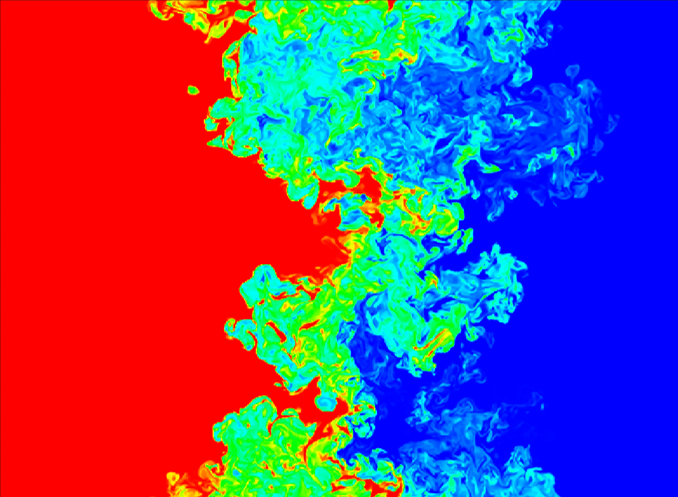When a shockwave crosses a density jump, it creates conditions conducive to what is known as the Richtmyer-Meshkov instability. If the density contact is seeded with imperfections, they can grow under the influence of the vorticity deposited by the incident shock. Thus the interface will continue to grow long after the shock has left the scene. The details of the flow depend on a wide selection of parameters such as the Mach number of the original shock, the compressibilities of the gases, the density difference between the gases and the nature of the initial perturbations at the interface. Similar to the Rayleigh-Taylor Instability, the Richtmyer-Meshkov flow plays a prominent role in nuclear fusion and in supernovae explosions.
What is a Supernova?
When a dense star known as a white dwarf gains mass through an accretion process from a companion star, its core can become so heavy that it collapses on itself triggering a runaway thermonuclear reaction. This process plays out over several billions of years, but the subsequent shockwave that blasts radially outward lasts only a few seconds, and is capable of ejecting the stellar matter far in to the emptiness of space. It is believed that the material thus ejected in to space is critical to the formation of earth-like planets and ultimately life. The luminosity of a supernova explosion can be as bright as that of several million suns. The turbulent mixing initiated by the advancing flamefront from the nuclear reaction can lead to detonation and a shockwave that travels radially outward. The outward bound shockwave can in turn accelerate matter contained in the heavier inner core past the less dense outer regions of the star this is similar to the instability caused by placing a heavy fluid over a light fluid under the influence of gravitational acceleration.

Figure: Turbulent mixing between heavy (red) and light (blue) fluids, induced by a shockwave (traveling from left to right) through the Richtmyer-Meshkov instability.
Related Publications:
- G. Dimonte & P. Ramaprabhu, “Simulations and model of the nonlinear Richtmyer-Meshkov instability”, Phys. Fluids, 22, 014104 (2010). https://doi.org/10.1063/1.3276269
- Y. Zhou, R.J.R. Williams, P. Ramaprabhu et al., “Rayleigh-Taylor and Richtmyer-Meshkov instabilities: A journey through scales”, Physica D, 423, 132838 (2021). https://doi.org/10.1016/j.physd.2020.132838
- B. Thornber et al., “Late-time growth rate, mixing, and anisotropy in the multimode narrowband Richtmyer-Meshkov instability: The theta-group collaboration”, Phys. Fluids, 29, 105107 (2017). https://doi.org/10.1063/1.4993464
- N. Attal & P. Ramaprabhu, “Numerical investigation of a single-mode chemically reacting Richtmyer-Meshkov instability”, Shock Waves, 25, 307-328 (2015).
